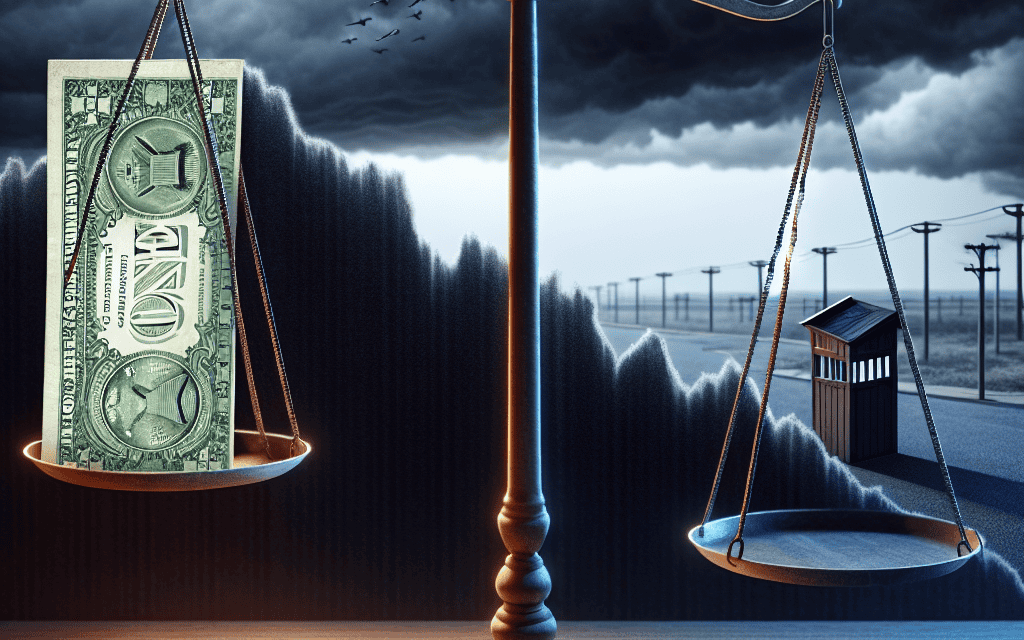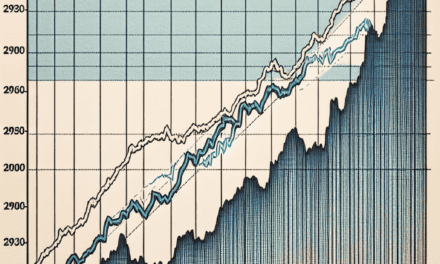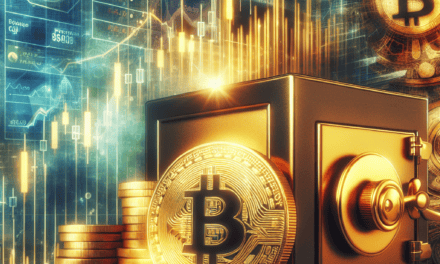“Uncertainty Rises: Dollar Dips Amid Election Jitters and Rate Cut Speculation”
Introduction
As the United States approaches a pivotal election period, the financial markets are experiencing heightened volatility, with the dollar showing signs of weakness. Investors are closely monitoring the political landscape, as the outcome of the election could significantly influence economic policies and market dynamics. Concurrently, there is growing anticipation of a potential rate cut by the Federal Reserve, aimed at bolstering economic growth amid ongoing uncertainties. This dual focus on political developments and monetary policy adjustments is contributing to fluctuations in currency valuations, with the dollar slipping as traders weigh the implications of these critical events. The interplay between electoral outcomes and central bank strategies is poised to shape the financial environment in the coming months, making it a crucial period for market participants.
Impact Of US Elections On The Dollar: Historical Trends And Current Predictions
As the United States approaches another pivotal election, the financial markets are closely monitoring the potential impacts on the dollar, a currency that often serves as a global benchmark. Historically, U.S. elections have had a significant influence on the dollar’s value, with various factors contributing to its fluctuations. The anticipation of policy changes, shifts in economic priorities, and the overall political climate can all play a role in shaping investor sentiment and, consequently, the strength of the dollar.
Looking back at previous election cycles, it is evident that the dollar often experiences volatility in the months leading up to and following an election. For instance, during the 2016 presidential election, the dollar initially strengthened as markets reacted to the unexpected victory of Donald Trump, driven by expectations of tax cuts and deregulation. However, this initial surge was followed by periods of uncertainty as the administration’s policies unfolded. Similarly, the 2020 election saw the dollar weaken amid heightened political tensions and the economic challenges posed by the COVID-19 pandemic.
In the current election cycle, the dollar is once again under scrutiny. With the Federal Reserve signaling a potential rate cut, investors are weighing the implications for the currency. A rate cut typically reduces the yield on dollar-denominated assets, making them less attractive to investors seeking higher returns. Consequently, this can lead to a depreciation of the dollar as capital flows shift towards currencies with more favorable interest rates. Moreover, the prospect of a rate cut reflects concerns about the U.S. economy’s growth trajectory, adding another layer of complexity to the dollar’s outlook.
As the election draws nearer, market participants are also considering the potential policy shifts that could arise from a change in administration. Each political party brings its own set of economic priorities, which can influence fiscal policy, trade relations, and regulatory frameworks. These factors, in turn, affect the dollar’s value as investors adjust their expectations based on the anticipated direction of U.S. economic policy. For example, a government that prioritizes fiscal stimulus and infrastructure spending might lead to a different market reaction compared to one focused on deficit reduction and austerity measures.
Furthermore, geopolitical considerations are playing an increasingly important role in shaping the dollar’s trajectory. The global economic landscape is marked by uncertainties, including trade tensions, supply chain disruptions, and shifting alliances. The outcome of the U.S. election could have far-reaching implications for international relations, potentially impacting the dollar’s status as the world’s reserve currency. Investors are keenly aware of these dynamics, and their perceptions of geopolitical risk can influence currency markets significantly.
In conclusion, the interplay between the upcoming U.S. election and the Federal Reserve’s monetary policy decisions is creating a complex environment for the dollar. Historical trends suggest that elections can lead to increased volatility, and current predictions indicate that this cycle will be no different. As investors navigate these uncertainties, they will be closely watching for any signals that could provide clarity on the future direction of U.S. economic policy and its implications for the dollar. Ultimately, the outcome of the election and the Fed’s actions will be pivotal in determining the dollar’s path in the months ahead, underscoring the intricate relationship between politics, economics, and currency markets.
Federal Reserve’s Rate Cut: What It Means For The US Economy
As the United States approaches a pivotal election period, the financial markets are closely monitoring the potential implications for the economy, particularly in light of the Federal Reserve’s anticipated rate cut. The dollar has recently experienced a decline, a movement that reflects the uncertainty surrounding both the political landscape and the Federal Reserve’s monetary policy decisions. This confluence of factors is shaping investor sentiment and influencing economic forecasts.
The Federal Reserve, tasked with steering the economy through monetary policy, is expected to implement a rate cut in response to a variety of economic indicators. This decision is largely driven by the need to stimulate economic growth amid signs of a slowdown. Lowering interest rates typically encourages borrowing and investment, as it reduces the cost of loans for consumers and businesses. Consequently, this can lead to increased spending and investment, which are crucial for sustaining economic momentum.
However, the timing of this anticipated rate cut coincides with the upcoming US election, adding a layer of complexity to the economic outlook. Elections inherently bring a degree of uncertainty, as potential shifts in policy and leadership can have significant implications for economic strategy. Investors are particularly sensitive to these changes, as they can affect everything from tax policies to international trade agreements. The interplay between the Federal Reserve’s actions and the political environment is therefore a critical factor in shaping market expectations.
Moreover, the weakening of the dollar is a reflection of these uncertainties. A softer dollar can have mixed effects on the economy. On one hand, it can boost exports by making American goods cheaper for foreign buyers, potentially narrowing the trade deficit. On the other hand, it can increase the cost of imports, contributing to inflationary pressures. The Federal Reserve must carefully balance these outcomes as it considers its rate cut strategy.
In addition to domestic factors, global economic conditions also play a role in the Federal Reserve’s decision-making process. The international economic landscape is currently characterized by volatility, with geopolitical tensions and trade disputes contributing to an unpredictable environment. These global dynamics can influence the US economy by affecting trade flows and investment patterns, further complicating the Federal Reserve’s task of maintaining economic stability.
As the election draws nearer, the Federal Reserve’s actions will be scrutinized not only for their immediate impact on the economy but also for their longer-term implications. A rate cut, while potentially beneficial in the short term, must be weighed against the risk of fostering asset bubbles or encouraging excessive risk-taking in financial markets. The Federal Reserve’s challenge lies in implementing a policy that supports growth without compromising financial stability.
In conclusion, the anticipated Federal Reserve rate cut, set against the backdrop of an impending US election, presents a complex scenario for the American economy. The interplay of domestic political uncertainty, global economic conditions, and monetary policy decisions will be pivotal in shaping the economic landscape in the coming months. As investors and policymakers navigate this intricate environment, the focus will remain on achieving a balance that promotes sustainable growth while mitigating potential risks.
How Political Uncertainty Affects Currency Markets
As the United States approaches another pivotal election, the financial markets are experiencing heightened volatility, with the dollar slipping against a basket of major currencies. This decline is not merely a reflection of domestic economic indicators but is intricately tied to the political uncertainty that often accompanies election cycles. Investors, wary of potential shifts in policy and governance, tend to adopt a cautious stance, leading to fluctuations in currency valuations. The anticipation of a Federal Reserve rate cut further compounds this uncertainty, as market participants attempt to navigate the dual influences of political and monetary policy changes.
Political uncertainty can have profound effects on currency markets, primarily because it introduces an element of unpredictability that investors typically seek to avoid. In the context of the US election, the stakes are particularly high, with potential implications for trade policies, fiscal strategies, and international relations. Each of these factors can significantly impact the dollar’s strength. For instance, a shift towards more protectionist trade policies could lead to a decrease in international trade volumes, thereby affecting the demand for the dollar. Conversely, a more open trade stance might bolster the currency by enhancing economic growth prospects.
Moreover, the Federal Reserve’s monetary policy decisions are closely watched by investors, as they directly influence interest rates and, consequently, currency values. The anticipation of a rate cut suggests that the Fed is aiming to stimulate economic activity by making borrowing cheaper. While this can be beneficial for domestic growth, it often results in a weaker dollar, as lower interest rates tend to reduce the returns on investments denominated in the currency. This dynamic is further complicated by the global context, where other central banks may also be adjusting their policies in response to economic conditions, creating a complex interplay of factors that influence currency markets.
In addition to these economic considerations, the psychological impact of political uncertainty cannot be underestimated. Investors often react to perceived risks by seeking safe-haven assets, such as gold or the Swiss franc, which can lead to a depreciation of the dollar. This behavior is driven by the desire to protect capital from potential losses associated with political upheaval or policy shifts. As a result, even the mere possibility of significant political change can lead to substantial movements in currency markets.
Furthermore, the interconnectedness of global economies means that political developments in the US can have ripple effects across the world. For example, changes in US trade policy could affect the economic outlook of trading partners, influencing their currencies and, in turn, impacting the dollar. This interconnectedness underscores the importance of considering both domestic and international factors when assessing the potential impact of political uncertainty on currency markets.
In conclusion, the current slip in the dollar’s value as the US election looms and a Federal Reserve rate cut is anticipated highlights the intricate relationship between political uncertainty and currency markets. Investors must navigate a complex landscape where political developments, monetary policy decisions, and global economic conditions all play a role in shaping currency valuations. As such, understanding these dynamics is crucial for making informed investment decisions in an increasingly interconnected and unpredictable world.
The Relationship Between Interest Rates And Currency Valuation

The intricate relationship between interest rates and currency valuation is a fundamental aspect of global economics, influencing the financial markets and the broader economy. As the US dollar recently experienced a decline, this dynamic interplay has come under increased scrutiny, particularly with the impending US election and the anticipated Federal Reserve rate cut. Understanding how these elements interact is crucial for investors, policymakers, and economists alike.
Interest rates, set by a country’s central bank, are a primary tool for regulating economic activity. When a central bank, such as the Federal Reserve, adjusts interest rates, it directly impacts the currency’s value. Typically, higher interest rates offer lenders in an economy a higher return relative to other countries. Consequently, higher rates attract foreign capital and cause the currency to appreciate. Conversely, lower interest rates can lead to depreciation as they offer less attractive returns on investments denominated in that currency.
In the current economic climate, the US dollar’s depreciation can be attributed to several factors, including the looming US election and the anticipated rate cut by the Federal Reserve. The political uncertainty surrounding an election can lead to volatility in financial markets, as investors often adopt a cautious approach, waiting to see the election’s outcome and its potential impact on economic policy. This uncertainty can weaken the currency as investors seek stability in other assets or currencies.
Moreover, the Federal Reserve’s potential rate cut is a significant factor influencing the dollar’s value. A rate cut typically signals an attempt to stimulate economic growth by making borrowing cheaper, thereby encouraging spending and investment. However, it also means that returns on investments in US dollars become less attractive compared to other currencies with higher interest rates. This shift can lead to a decrease in demand for the dollar, causing it to depreciate.
The relationship between interest rates and currency valuation is not isolated to the US; it is a global phenomenon. Central banks worldwide adjust their interest rates in response to domestic economic conditions and international developments. As such, the actions of the Federal Reserve can have ripple effects across global markets. For instance, if the Fed cuts rates, other central banks may follow suit to maintain competitive exchange rates, impacting their currencies’ valuations.
Furthermore, the interplay between interest rates and currency valuation is influenced by other economic indicators, such as inflation, employment rates, and GDP growth. These factors can affect a central bank’s decision-making process regarding interest rates. For example, if inflation is rising, a central bank might increase interest rates to cool down the economy, which could lead to currency appreciation.
In conclusion, the relationship between interest rates and currency valuation is a complex and dynamic aspect of economic policy and financial markets. As the US dollar experiences fluctuations due to the upcoming election and potential Federal Reserve rate cuts, understanding this relationship becomes even more critical. Investors and policymakers must consider not only domestic factors but also the broader global economic context to navigate these changes effectively. By doing so, they can better anticipate market movements and make informed decisions that align with their economic objectives.
Global Market Reactions To US Political And Economic Changes
As the United States approaches a pivotal election period, global markets are closely monitoring the potential implications of political and economic changes. The dollar, a cornerstone of international trade and finance, has recently experienced a decline, reflecting the uncertainty surrounding the upcoming election and the anticipated monetary policy adjustments by the Federal Reserve. This confluence of political and economic factors is shaping investor sentiment and influencing market dynamics worldwide.
The approaching US election has introduced a layer of unpredictability into the financial markets. Historically, elections can lead to volatility as investors attempt to gauge the potential impact of new policies on the economy. This year, the stakes are particularly high, with significant issues such as fiscal policy, international trade relations, and regulatory changes hanging in the balance. As candidates outline their platforms, market participants are keenly assessing how different outcomes might affect economic growth and stability. Consequently, the dollar’s recent slip can be attributed, in part, to the apprehension surrounding these political developments.
In tandem with the political landscape, the Federal Reserve’s monetary policy is another critical factor influencing the dollar’s trajectory. Market analysts widely anticipate a rate cut by the Fed, a move aimed at stimulating economic activity amid signs of slowing growth. Lower interest rates typically reduce the appeal of holding a currency, as they offer lower returns on investments denominated in that currency. As a result, the prospect of a rate cut has exerted downward pressure on the dollar, prompting investors to seek alternative assets that might offer better returns.
Moreover, the interplay between US monetary policy and global economic conditions cannot be overlooked. The Federal Reserve’s decisions reverberate across international markets, affecting everything from emerging market currencies to commodity prices. A weaker dollar can have mixed implications for global economies. On one hand, it can provide relief to countries with dollar-denominated debt, making repayments more manageable. On the other hand, it can lead to increased volatility in foreign exchange markets, complicating trade and investment decisions for businesses worldwide.
As the dollar slips, other currencies are experiencing shifts in value, reflecting the interconnectedness of global markets. The euro, for instance, has seen a modest appreciation, buoyed by the relative stability of the European economy and the European Central Bank’s cautious approach to monetary policy. Similarly, the Japanese yen has strengthened, often viewed as a safe-haven currency during times of uncertainty. These movements underscore the complex web of factors that influence currency valuations and highlight the importance of a nuanced understanding of global market dynamics.
In conclusion, the current decline of the dollar is emblematic of the broader uncertainties facing global markets as the US election looms and the Federal Reserve contemplates a rate cut. Investors are navigating a landscape marked by political unpredictability and economic recalibration, seeking to balance risk and opportunity in an ever-evolving environment. As these developments unfold, the interplay between US political and economic changes will continue to shape global market reactions, underscoring the intricate connections that define the modern financial system. Through careful analysis and strategic decision-making, market participants aim to mitigate risks and capitalize on emerging trends, ensuring resilience in the face of uncertainty.
Strategies For Investors Amidst Currency Fluctuations
As the US election approaches and speculation mounts regarding a potential Federal Reserve rate cut, investors are closely monitoring the fluctuations in the value of the dollar. The currency’s recent slip has prompted a reevaluation of strategies, as market participants seek to navigate the uncertainties that lie ahead. Understanding the dynamics at play is crucial for investors aiming to make informed decisions in this volatile environment.
The dollar’s decline can be attributed to a confluence of factors, with political uncertainty being a significant driver. As the election draws near, the potential for policy shifts and changes in economic direction creates an atmosphere of unpredictability. Investors are wary of the implications that different electoral outcomes could have on fiscal policy, trade agreements, and international relations. Consequently, this uncertainty has led to a cautious approach, with many opting to diversify their portfolios to mitigate potential risks.
In addition to political factors, the anticipation of a Federal Reserve rate cut adds another layer of complexity. The central bank’s monetary policy decisions are closely scrutinized, as they have a direct impact on currency valuation. A rate cut typically leads to a depreciation of the dollar, as lower interest rates make the currency less attractive to investors seeking higher returns. This expectation has already influenced market behavior, with some investors preemptively adjusting their positions in anticipation of such a move.
Given these circumstances, investors are exploring various strategies to safeguard their investments and capitalize on potential opportunities. Diversification remains a cornerstone of risk management, as spreading investments across different asset classes can help cushion against currency volatility. By including assets denominated in other currencies, investors can reduce their exposure to the dollar’s fluctuations and potentially benefit from gains in other markets.
Moreover, hedging strategies are gaining traction as a means to protect against adverse currency movements. Instruments such as currency futures and options allow investors to lock in exchange rates, providing a degree of certainty in an otherwise uncertain environment. These tools can be particularly useful for businesses engaged in international trade, as they help manage the risks associated with fluctuating exchange rates.
In addition to these traditional approaches, some investors are turning to emerging markets as a potential avenue for growth. While these markets come with their own set of risks, they also offer opportunities for higher returns, especially if the dollar continues to weaken. By carefully selecting investments in regions with strong economic fundamentals and growth prospects, investors can potentially offset losses incurred from a declining dollar.
Furthermore, maintaining a long-term perspective is essential in navigating currency fluctuations. While short-term volatility can be unsettling, it is important to remember that currency markets are inherently cyclical. By focusing on fundamental analysis and maintaining a disciplined investment approach, investors can better position themselves to weather the storm and achieve their financial objectives.
In conclusion, the current environment of political uncertainty and anticipated monetary policy changes presents both challenges and opportunities for investors. By employing a combination of diversification, hedging, and strategic allocation to emerging markets, investors can effectively manage the risks associated with currency fluctuations. As the US election looms and the possibility of a Federal Reserve rate cut remains on the horizon, staying informed and adaptable will be key to navigating this complex landscape.
The Future Of The Dollar: Expert Opinions And Forecasts
As the United States approaches a pivotal election period, the financial markets are abuzz with speculation and analysis regarding the future trajectory of the US dollar. The currency, which has long been considered a global benchmark, is currently experiencing a period of volatility. This uncertainty is compounded by the anticipation of a potential interest rate cut by the Federal Reserve, a move that could have significant implications for the dollar’s value. Experts are closely monitoring these developments, offering a range of opinions and forecasts on what lies ahead for the greenback.
To begin with, the political landscape in the United States is a critical factor influencing the dollar’s performance. Historically, election periods have been associated with increased market volatility, as investors grapple with the potential policy shifts that could arise from a change in administration. This year is no exception, with the stakes particularly high given the current economic climate. The outcome of the election could lead to significant changes in fiscal policy, trade agreements, and international relations, all of which have direct implications for the dollar’s strength.
In parallel, the Federal Reserve’s monetary policy decisions are under intense scrutiny. The possibility of an interest rate cut looms large, as the Fed seeks to navigate the complex economic landscape marked by inflationary pressures and uneven growth. A rate cut typically leads to a depreciation of the currency, as lower interest rates make the dollar less attractive to investors seeking higher returns. This potential move by the Fed is seen as a double-edged sword; while it could stimulate domestic economic activity, it may also weaken the dollar’s position on the global stage.
Amidst these dynamics, expert opinions on the future of the dollar are varied. Some analysts argue that the dollar’s current weakness is temporary, suggesting that once the election uncertainty dissipates and the Fed’s policy direction becomes clearer, the currency could regain its footing. They point to the underlying strength of the US economy, which, despite recent challenges, remains one of the most robust in the world. Furthermore, the dollar’s status as a safe-haven asset continues to attract investors during times of global uncertainty, providing a buffer against prolonged depreciation.
Conversely, other experts caution that the dollar may face a more sustained period of weakness. They highlight structural factors such as the growing US debt burden and the increasing competitiveness of other currencies, particularly the euro and the Chinese yuan. These analysts suggest that the dollar’s dominance in international trade and finance could gradually erode, leading to a more multipolar currency landscape. Additionally, geopolitical tensions and shifts in global alliances could further challenge the dollar’s preeminence.
In conclusion, the future of the US dollar is intricately linked to both domestic and international developments. As the US election approaches and the Federal Reserve contemplates its next moves, the currency’s path remains uncertain. While some experts remain optimistic about the dollar’s resilience, others foresee potential challenges that could alter its long-standing role in the global economy. As these events unfold, market participants and policymakers alike will be closely watching, aware that the implications of these developments extend far beyond the currency markets, influencing global economic stability and growth.
Q&A
1. **What is the current trend of the US dollar as the election approaches?**
The US dollar is slipping in value as the election approaches.
2. **What is the anticipated action by the Federal Reserve?**
A rate cut by the Federal Reserve is anticipated.
3. **How does the upcoming US election impact the dollar?**
The uncertainty surrounding the US election is contributing to the dollar’s decline.
4. **What are investors focusing on in relation to the Federal Reserve?**
Investors are focusing on the potential for a rate cut by the Federal Reserve.
5. **How might a Federal Reserve rate cut affect the US dollar?**
A rate cut could further weaken the US dollar.
6. **What are the broader market implications of a weaker dollar?**
A weaker dollar could impact global trade and investment flows.
7. **What is the general sentiment in the financial markets regarding the US dollar?**
The sentiment is cautious due to election uncertainty and potential monetary policy changes.
Conclusion
The dollar’s decline as the U.S. election approaches and expectations of a Federal Reserve rate cut highlight the interplay between political uncertainty and monetary policy on currency markets. Investors often seek stability, and the prospect of a rate cut typically weakens a currency by reducing returns on investments denominated in that currency. As the election introduces potential shifts in economic policy, market participants may be hedging against volatility, further pressuring the dollar. This scenario underscores the sensitivity of currency valuations to both domestic political developments and central bank actions, with broader implications for global trade and investment flows.





